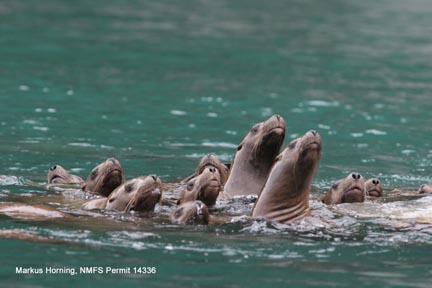News & Events
This section contains current news and events as well as project team biographies and a telemetry blog. Discover where telemetry tags show that juvenile Steller sea lions are dying in Alaska. See a recent map of mortality events below.
Moving all updates to www.WildlifeTechnologyFrontiers.com
Updated in March 2023
We are moving all updates on our tagging, telemetry and technology activities to our new website!
Check out the new website for Wildlife Technology Frontiers,
the new home organization of the Laboratory for Applied Biotelemetry.
Wildlife Technology Frontiers is the public face of the Alaska Marine Science Association LLC.
Moving all updates to Facebook Wildlife Technology Frontiers on FACEBOOK New papers out from our LHX project! Bishop AM, Brown CL, Sattler R, Horning M (2020) An Integrative Method for Characterizing Marine Habitat Features Associated With Predation: A Case Study on Juvenile Steller Sea Lions (Eumetopias jubatus). Frontiers in Marine Science 7:576716. Bishop AM, Dubel AK, Sattler R, Brown CL, Horning M (2019) Wanted dead or alive: characterizing likelihood of juvenile Steller sea lion predation from diving and space use patterns. Endangered Species Research 40:357-367. Brown C, Horning M, Bishop A (2019) Improving emergence location estimates for Argos pop-up transmitters. Animal Biotelemetry 7:4. Horning M, Andrews RD, Bishop A, et al. (2019) Best practice recommendations for the use of external telemetry devices on pinnipeds. Animal Biotelemetry 7:20. Moving all updates to 60 North Science 60 North Science - new ASLC science blog
Updated in May 2021
We are moving all updates on our tagging, telemetry and technology activities to Facebook!
Check out the renamed Facebook page for Wildlife Technology Frontiers,
the new home of the Laboratory for Applied Biotelemetry.
Updated in December 2020
Check out our most recent papers resulting from, or closely related to the LHX project (in 2020 and 2019):
Updated on November 13th, 2017
We are fully switching to our new 60 North Science blog at the Alaska SeaLife Center for all updates related to the LHX project and related projects and developments:
60 North Science.
We have set up two tags to allow you to access blog entries related to the following specific topics:
See all 60 North Science entries on LHX tags here
See all 60 North Science entries on Sleeper sharks here
On the 60 North Science blog, you can sign up to receive email alerts whenever there is a new entry - follow us!
Updated on November 1st, 2017
You can follow our various LHX projects and activities - as well as many other projects - through the new Science Blog of the Alaska SeaLife Center.
60 North Science.
Another new species, another major milestone in the LHX project
Updated on September 1st, 2017
We're truly excited to report that we are now using the smaller 2nd generation LHX2 tags in sea otters! Yes! After successful initial trials under highly controlled conditions conducted at the Monterey Bay Aquarium, more recently single LHX2 tags were implanted in two rehabilitated male Southern sea otters at The Marine Mammal Center in Sausalito, CA. Both animals were afflicted with Domoic Acid Toxicosis. Both were released back into the wild after receiving single LHX2 tags.
You can read up on this effort in the following entry of our new ASLC Science Blog: New Milestones in Southern Sea Otter Conservation.
New paper on best practice in the use of implanted telemetry devices
Updated on July 1st, 2017
There are accepted guidelines and recommendations for conducting responsible research in an ethical manner, but few are specific to wild animals, and even fewer to the use of external or internal telemetry devices. Our new paper reviews what the wildlife research community has learned in more than 30 years of work with implanted devices, so that we can optimize the process of using such tags. We placed particular emphasis on our own extensive practical experience using LHX tags on California sea lions, Steller sea lions and Pacific harbor seals, under controlled and free-ranging conditions. In a way, gained knowledge is synthesized into a description of the state of the art. This information is important in designing and implementing studies, and is useful for regulators in evaluating projects. Here is the full and downloadable reference:
Horning M, Haulena M, Tuomi PA, Mellish JE, Goertz CE, Woodie K, Berngartt RK, Johnson S, Shuert CR, Walker KA, Skinner JP, Boveng PL (2017) Best practice recommendations for the use of fully implanted telemetry devices in pinnipeds. Animal Biotelemetry 5:13.
You can also read a brief summary of this paper written for the general public, in our new ASLC science blog: 60 North Science.
New paper on first use of LHX tags in a new species
Updated on June 1st, 2017
In 2014, we started using the smaller, 2nd generation LHX2 tags in a new species: harbor seals (see earlier entry below). At the Vancouver Aquarium, we successfully implanted three young harbor seal pups that had just completed the rehabilitation process, with single LHX2 tags. The animals were relased after an extended period of observation, and tracked via external tags for another nine months. Just recently, we published a new paper on this milestone:
Horning M, Haulena M, Rosenberg JF, Nordstrom C (2017) Intraperitoneal implantation of life-long telemetry transmitters in three rehabilitated harbor seal pups. BMC Veterinary Research 13: 139.
You can also read a brief summary of this paper written for the general public, in our new ASLC science blog: 60 North Science.
Another major milestone in the LHX project
Updated on November 1st, 2016
In September of this year, we participated in a research cruise to the western Aleutian Islands to conduct research on the declining population of harbor seals. The cruise was organized, led, financed and conducted by the Marine Mammal Lab of the NMFS. The Mammal Lab team captured and tagged a total of 36 harbor seals, and we were able to implant dual LHX2 tag in a subset of 10 of these seals. The animals were implanted within a few hours of capture, and were released within two to three hours of surgery.
You can read up on this effort in the NOAA / NMFS field blog reporting on this project: Dispatches from the field: Studying at-risk harbor seals in the western Aleutians.
Recent Mortality Events
Updated on February 1st, 2016
As of February 1st, 2016, we have detected 20 mortality events in our juvenile Steller sea lion study. A brief recap: between 2005 and 2014, we released 45 young, weaned Steller sea lions in the Prince William Sound / Kenai Fjords region, with LHX tags. At least 18 of these 20 detected mortality events were due to predation. In two cases, we did not receive enough data to determine the likely cause of mortality. In five cases the data suggests that the animals died by predation from Pacific sleeper sharks. The three most recent events are all young females that were relase in our 2014 round of deployments (see below) that had received 2nd generation LHX2 tags. Two of these animals passed away in 2015 (in April and June, respectively), and one just a few days ago, on January 25th, 2016.
Our most important 'Control Publication' yet
Updated on Nov 8th, 2015
Our latest publication related to the LHX project just appeared in the online Open Access journal PLoS ONE:
Shuert C, Horning M, Mellish JE (2015) The Effect of Novel Research Activities on Long-term Survival of Temporarily Captive Steller Sea Lions (Eumetopias jubatus). PLoS ONE 10(11): e0141948.
This is the first comprehensive analysis of any possible impact of all of our treatments combined, on survival of our study animals. The treatments considered include capture, transportation, captivity, implant surgery, health assessment, external tagging, and release. While our initial sample size and therefore power of comparison remains limited, the good news is that we have no evidence to date of any negative effect of LHX tags or surgery, on survival of our study animals.
First LHX use in a new species: Pacific harbor seals
Updated on December 1st, 2014
Recently we had an opportunity to use the much smaller, 2nd generation LHX2 tags in three very young harbor seal pups that had completed rehabilitation at the Vancouver Aquarium. The Vancouver Aquarium rehabilitates many dozens of stranded harbor seal pups in the Salish Sea every year. Like with other stranding organizations, there is a keen interest in determining how well the rehab process works, and what its impact on the wild population might be: will the rehabilitated animals survive in the wild, how long will they live, and - most importantly - will they breed? With LHX tags we now have a tool at hand to begin to seek answers to these important questions.
Stand by to hear more from us about this new project in the future!
Autopsies from space: who
killed the sea lions?
Updated on November 25th, 2014
Read up on our sleuthing out of what predators could be responsible for
some of the sea lion deaths we observed via the use of LHX tags.
Read
the article in The Conversation.
YouTube video of a seminar
by Dr. Markus Horning on the topic of Sleeper shark predation on Steller
sea lions
Updated on November 24th, 2014
On Friday, Nov 20th, 2014, Dr. Horning gave a seminar presentation at
the Fisheries Centre of the University of British Columbia.
Watch
this lecture on You Tube.
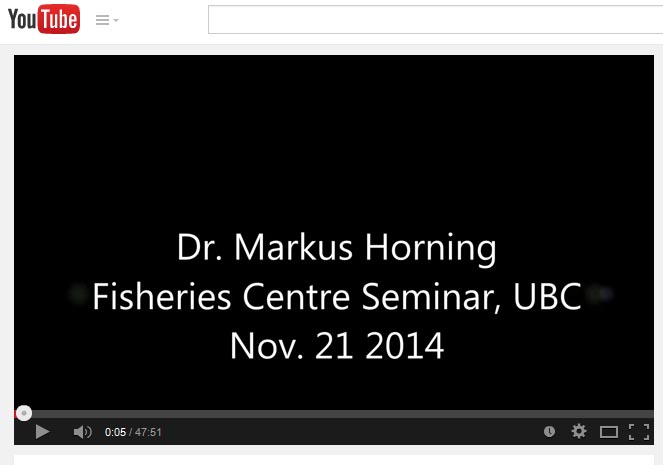
New publication with some
startling results
Updated on Oct 21st, 2014
Our latest paper just appeared in the scientific journal Fishery Bulletin:
Horning M, Mellish JE (2014) In
cold blood: evidence of Pacific sleeper shark (Somniosus pacificus) predation
on Steller sea lions (Eumetopias jubatus) in the Gulf of Alaksa. Fishery
Bulletin 112:297-310.
.... and guess what?
We found some pretty compelling evidence that some of the predators that
are attacking young Steller sea lions in our study area, are Pacific
sleeper sharks. This may seem improbable, as 'sleepers' are thought
by some to be slow moving, sluggish, bottom dwelling scavengers. Well,
think again! Better yet, read our paper!
Or read
a synopsis in this OSU press release on our new findings.
More LHX2 tags out!
Updated on Sept 15th, 2014
And we completed our second round of LHX2 tag deployments just recently.
We caught, implanted, and released another four female Steller sea lions,
bringing the total number of animals that have received 2nd generation
LHX2 tags to 9!
Getting LHX2 tags out!
Updated on May 15th, 2014
We are starting the next stage of the LHX project! Under funding from
the North Pacific Research Board, the Pollock COnservation Cooperative
Research Center, the North Pacific Fisheries Foundation and the Alaska
SeaLife Center, we recently captured six young female Steller sea lions
in Prince William Sound. Five of the six animals were just released with
LHX implants that can detect parturition. These tags will later tell us
at what age these females had their first pup, and how many pups they
will have born by the time they die. The 6th female was also released
but with only an external tracking device. She will sereve as a control.
Recent Mortality Events
Updated on February 1st, 2014
As of February 1st, 2014, we have detected 17 mortality events. At least
15 of these 17 events were due to predation. In two cases, we did not
receive enough data to determine the likely cause of mortality. In fourcases
the data suggests that the animals died by predation from Pacific sleeper
sharks.
This map of mortalities is based on satellite locations from the Life History Transmitter. Each dot indicates a place where a juvenile Steller sea lion has died. The red dots indicate Steller sea lions that have died due to predation, likely from transient killer whales. The blue dots also indicate sea lions that have died from predation, but in this case most likely by Pacific sleeper sharks. The white dots indicate insufficient information to determine a cause of death.
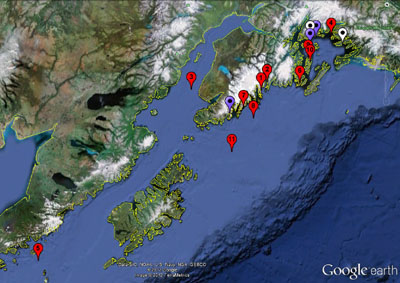
For more information, see the "Map of Mortalities" page under 'What Are We Learning?'.
Telemetry in the News
New study published today in the journal PLoS ONE
Our latest
publication resulting from the LHX tag project was published today
in the online Open Access journal PLoS
ONE. The paper presents a new population model that analyzes how predation
rates may change as the abundance of sea lions varies.This model is what
we call a qualitative conceptual model. This means it is a model that
presents 'what if' scenarios, rather than a quantitative model that attempts
to make specific and accurate predictions for certain circumstances. The
conceptual model is a thinking tool. However, our model suggests some
very interesting 'what if' scenarios. Specifically, the model suggests
that predation may be the main driver behind the western Steller sea lion
population trends. Furthermore, the model suggests that this effect may
come about because predators may focus their efforts on young sea lions.
This could result in fewer females surviving to sexual maturity and having
pups. This in turn could lead to the appearance of reduced birth rates
- which have been suggested as drivers of the population trends. Our model
instead suggests that this effect may actually stem from predation, and
that birth rates have not changed at all. This publication is available
for the general public to download and freely distribute. Click
here to download this publication from the PLoS ONE website.
Check out this nicely done write-up
on our project on the website of the North Pacific Universities Marine
Mammal Research Consortium:
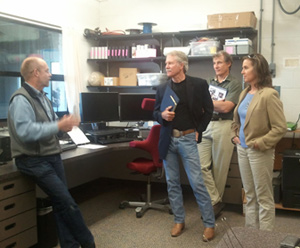 Oregon Governor and First Lady Learn about Life History Transmitters
Oregon Governor and First Lady Learn about Life History Transmitters
Oregon Governor John Kitzhaber and First Lady Cylvia Hayes visited the Pinniped Applied Ecology Research Laboratory (PEARL) as part of their visit to the Marine Mammal Institute at the Hatfield Marine Science Center. “Governor Kitzhaber and First Lady Hayes have a genuine interest in marine science,” says Dr. Markus Horning of PEARL. Dr. Horning showed the Governor and First Lady the Life History Transmitter Tags that he implants in Steller sea lions to study how they are dying. “They seemed to find the project interesting and fascinating,” says Dr. Horning. Dr. Horning described how the tag detects mortality and how it distinguishes predation and non-predation events. “The Governor and First Lady even participated in a impromptu brainstorming session related to recent mortality events,” chimes Dr. Horning. Dr. Horning explained that the latest Steller sea lion death may likely be due to predation by a shark. The Governor, First Lady, and Dr. Horning considered how to modify a sensor on the tag to register that it is in a shark’s stomach.
Photo: (L to R) Dr. Markus Horning, Governor Kitzhaber, Gil Sylvia (Superintendent of the Coastal Oregon Marine Experiment Station), Cylvia Hayes (the Governor's partner and First Lady of Oregon). Photographer: Heather Bene, Oregon State University Government Relations.
Last Capture Cruise Ended with an Exciting Re-sight
This June marked the 15th and possibly last capture cruise for the Life History Transmitter Project. On June 2nd, a team from the Alaska Sea Life Center and Oregon State University went out to capture the last four juvenile Steller sea lions of the project at Glacier Island in Prince William Sound. At the haul-out they had a pleasant surprise, the team saw a seven-year-old female who received one of the first two LHX implants. (She is visible in the photo below as =908.) “She appeared to be healthy and doing well. We hope we will see her with pups next year,” said Dr. Markus Horning. Scientists brand the animals to be able to identify them later and monitor their survival. They also saw two other animals that had received implants. Since the first capture cruise in August 2005, researchers captured 60 juvenile Steller sea lions and 37 received implants. "In this phase of the project, we are simply waiting for mortality events to occur,” Dr. Horning explains. Researchers anticipate that the cause of death in Steller sea lions may change as the study animals age.

This is one of the first two LHX-implanted animals, a female that was released in November of 2005 at the age of about 1.5 years. She is now 7 years old and doing well. She is marked with these characters, =908.
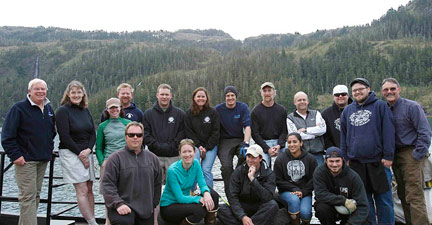
The success of these capture cruises depends on many individuals and staff at the Alaska SeaLife Center including the husbandry staff.
Dr. Bill Hanshumaker Presents Curriculum at NW NAME
Dr. Bill Hanshumaker will be presenting a poster at Northwest Aquatic and Marine Educator Conference in Port Angles, Washington about Studying Sea Lions Using Telemetry, the companion curriculum to this website. The conference will take place on July 13-16, 2011 at the Olympic Park Institute. We invite educators to attend Bill’s poster presentation and learn more about what the curriculum and website have to offer!
